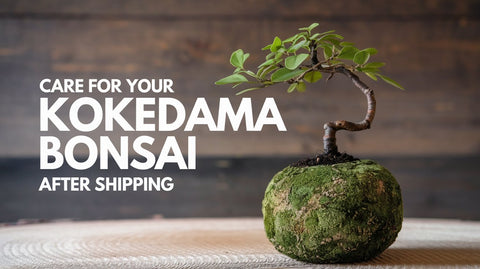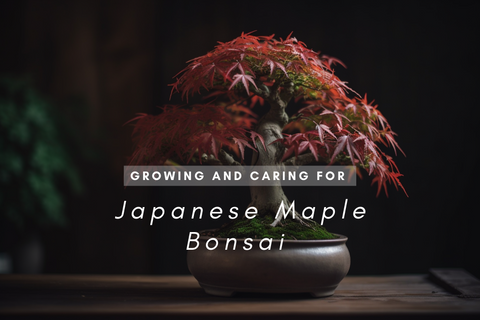
How To Grow Your Wisteria - From Seed To A Blossoming Tree
Wisteria are popular for their beautiful flowers that are used in flower arrangements. They are one of the most popular flowering plants in Japan. However, it can be difficult to find a wisteria plant in the store. This is because they need to be grown from seeds.

Growing a Wisteria Bonsai from seeds is not difficult at all. It only takes about three months to grow one and you can do it yourself at home with some simple steps to germinate wisteria seeds!
Wisteria (Fuji 藤) Seeds Germination
While some seeds, such as our Sakura require a longer germination period and more aggressive scarification to weaken their hard outer shell, Wisteria seeds have little to no dormancy period and can begin sprouting very quickly. A prior treatment with Scarification (weakening the hard outer shell) and is recommended by some for Wisteria seeds to achieve high germination rate, but with simple germination methods it is possible to have high success without scarification.
The Simple Steps to Growing Wisteria
What You Will Need
-
Your Purple Wisteria Seeds
-
A Jar or Container
-
Water
-
Small Planters
-
Soil
Wisteria Germination
Before you can plant wisteria seeds, it is important to germinate them first. For starting the germination process, put the Wisteria seeds in a jar and soak them for 3 days in water that's left at room temperature.

Some recommend wounding the outer shell or using lukewarm water to help germination - although this is often not necessary for Wisteria. If you would like to scarify your Wisteria seeds you can see the methods listed in our growing Sakura guide here

After 3 days, make sure your seeds are well hydrated. Then drain all the water from the jar leaving just enough to maintain a humid environment - you don't want too much moisture trapped in there!

The container should be inspected on a daily or semi-daily basis to allow fresh air in and check to see if there are germinated seeds. You may start to see some wisteria sprouts after 2-3 days of inspecting, but after several days you'll likely notice quite a few.

Look at the size difference between a dry seed as it comes out of the pod and a freshly germinated one.

Now that these seeds have sprouted, they need to be potted. For the Wisteria seeds, you'll want regular potting soil. Gently place each seed in a small hole below the surface and then cover them with a thin layer of soil. The final step in getting new plants potted is watering. Especially if the soil is dry.

*If some seeds don't show signs of germination, they'll go back in the jar for a longer germination time.
In a few more days, the potted wisteria will become little Wisteria plants and should start to pop up from the soil.
And this is how the Wisteria seedlings will look like after growing for a few more weeks.

A Wisteria plant has developed from each seed and they should grow well as Wisteria is such a fast growing plant. If the outside temperatures are still too low for your plants. Try growing these seedlings inside.
Wisteria is a fast growing, and wide spreading tree. There are houses here in Japan overtaken by Fuji plants, and while they look beautiful in the spring, you may want to make sure to trim them if you do not keep them as a bonsai. Their fast and easy growing nature makes them perfect for bonsai since you can trim them and experiment with different styles without needing to wait as long as some other types of trees.

Feel free to watch the video below for a video guide to starting your seeds.
Pruning Wisteria
Pruning wisteria is an important part of caring for this beautiful, flowering plant. Proper pruning can help to keep the plant healthy, encourage new growth, and improve the overall appearance of the wisteria.
When pruning wisteria, it is important to start by removing any dead, damaged, or diseased branches. This will help to keep the plant healthy and encourage new growth. Next, remove any branches that are crossing or rubbing against each other, as these can cause damage to the plant over time.
It is also a good idea to thin out the plant by removing some of the smaller, less vigorous branches. This will help to improve the overall appearance of the wisteria and encourage the remaining branches to grow more robustly.
Finally, prune the wisteria to maintain its desired shape. This may involve removing branches that are growing too long or too aggressively, or trimming back the plant to a more manageable size.
It is important to keep in mind that wisteria can be a fast-growing plant, and it may need to be pruned regularly to keep it in shape and prevent it from becoming overgrown. Pruning wisteria can be a bit of a daunting task, but with a little bit of patience and practice, you can learn to prune this beautiful plant with confidence.
Can Wisteria Grow in a Pot
While wisteria is often grown as a climbing vine, it can also be grown in a pot as a smaller, more contained plant.
If you are interested in growing wisteria in a pot, it is important to choose a pot that is large enough to accommodate the plant's root system. A pot with a diameter of at least 18 inches and a depth of at least 20 inches is recommended. Wisteria will also require a well-draining soil mixture and should be placed in a location that receives plenty of sunlight.
It is important to keep in mind that wisteria can be a fast-growing plant, and it may need to be pruned regularly to keep it from becoming too large for its pot. Additionally, wisteria may need to be transplanted into a larger pot as it grows, as a pot that is too small can limit the plant's growth and development.
Overall, wisteria can be grown successfully in a pot with the proper care and attention. By providing the plant with plenty of sunlight, a well-draining soil mixture, and a large enough pot to accommodate its root system, you can enjoy the beauty and fragrance of wisteria in a more contained setting.
Can Wisteria Be A Bonsai?
While wisteria is typically grown outdoors as a climbing vine, it can also be grown indoors as a indoor wisteria bonsai plant.
Growing wisteria as a bonsai requires a bit of patience and care, as the plant will need to be trained and pruned regularly to maintain its small size and desired shape. It is important to choose a pot that is small enough to contain the plant's root system, as a pot that is too large can lead to excessive growth. A well-draining soil mixture is also essential, as wisteria is susceptible to root rot if the soil remains too wet for extended periods of time.
When growing wisteria indoors as a bonsai, it is important to provide the plant with plenty of sunlight. A south-facing window is ideal, as wisteria requires at least six hours of direct sunlight per day to thrive. It is also important to keep the plant properly watered and fertilized, as these factors will help to keep it healthy and encourage flowering.
Overall, while it may require a bit of extra effort, it is possible to grow wisteria indoors as a bonsai plant. By providing the plant with the proper care and attention, you can enjoy the beauty and fragrance of wisteria in a more contained setting.
Wisteria Fun Facts!
Exploding Pods
Wisterias produce seed pods that contain flat, round seeds. The plant has an interesting way of distributing the seeds. As Wisteria seed pods dry out during the Spring they start to twist. There is an increasing tension in the pods which eventually causes them to pop open and release their seeds into the wind. If you bring Wisteria pods inside and hear something go "POP" in the middle of the night, it's just seeds that you collected from four Wisteria pods trying to spread out to be planted.
It’s a Bean
Not exactly, but Wisteria is part of the legume family. The legume family is also home to peas, beans, lentils and clover!
It Will Outlive You
It's a perennial plant that can live from 50 to 100 years or even longer.
Don’t Eat The Seeds
The seeds are carried in long, narrow legumes and are poisonous.
Two Types Of Wisteria
There are two types of wisteria. Chinese wisteria (wisteria sinensis) and Japanese Wisteria (Wisteria floribunda). Chinese wisteria seeds are the most common and result in vines that grow and wrap around in counterclockwise direction while Japanese wisteria wraps clockwise.
Watch Out For Vines
Wisteria are famous for their stretching vines. Wisteria vines can be seen growing across some houses here in Japan and you will even see them stretching across trees on the side of mountains.
Sakura Followed By Wisteria
In the spring Japan is beautiful, with the cherry and wisteria blooms. The wisteria typically begins to produce flowers in late April and early May (shortly after the cherry blossoms) depending on what kind of wisteria it is.



